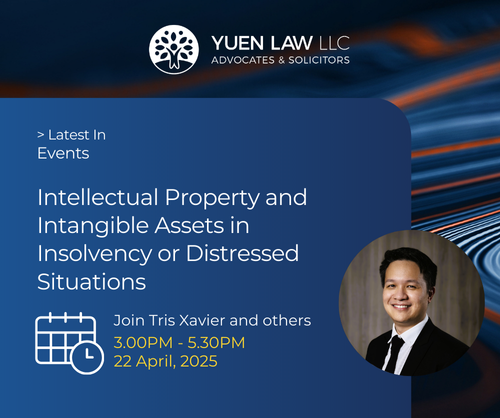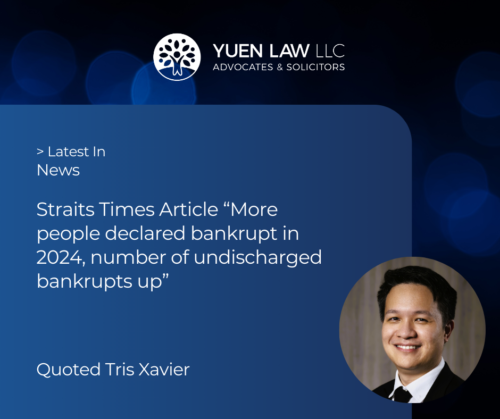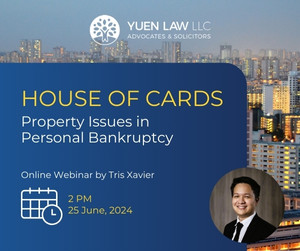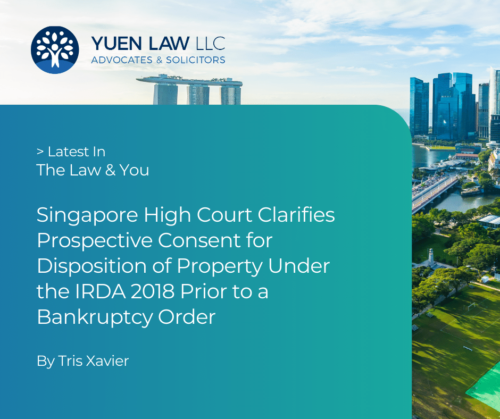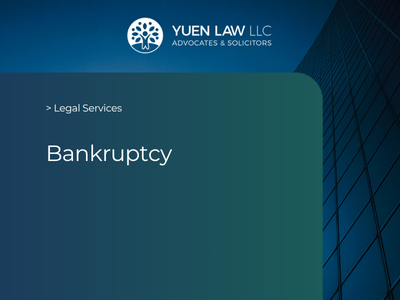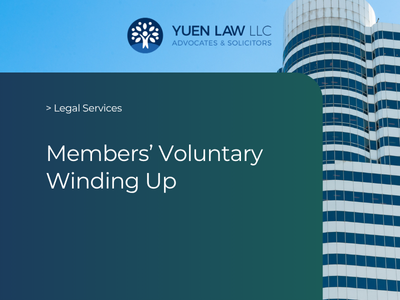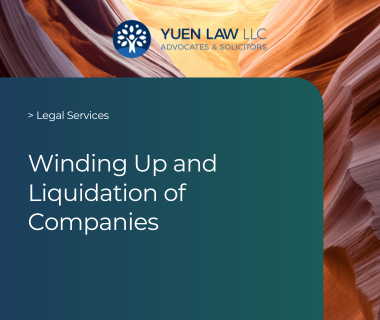
Personal Bankruptcy in Singapore
Bankruptcy can be commenced either by a creditor seeking repayment of unpaid debts, or by a debtor seeking relief from overwhelming debts. These debts can arise from unsecured loans owed to financial institutions, breaches of contract, private disputes between individuals, or trade debts.
Private Trustee in Bankruptcy (PTIB) to Handle All Bankruptcy Cases
Following changes to the Insolvency, Restructuring and Dissolution Act 2018, all personal bankruptcy orders made from 1 November 2023 must mandatorily be administered by Private Trustees in Bankruptcy (PTIB), save for cases deemed to be in the public interest, This is a marked departure from the previous regime, where only institutional creditors were required to appoint a Private Trustee in Bankruptcy (PTIB), and the remainder of the cases would be administered by the Official Assignee (OA), a statutory office under the Ministry of Law.
What This Means for Debtors and Creditors in Bankruptcy Proceedings
When applying to the Court for a bankruptcy order (be it against another person or themselves), a person must appoint a licensed insolvency practitioner to act as the trustee in bankruptcy, by obtaining written consent from the insolvency practitioner to administer the bankruptcy case before submitting the application. The Court will not issue a bankruptcy order on an application unless a licensed insolvency practitioner or the Official Assignee has consented to act as the trustee in bankruptcy.
As a licensed insolvency practitioner, we are qualified to administer bankruptcy estates of individuals.
Requirements to File for Bankruptcy
- The debtor owes a debt of at least S$15,000 and is unable to repay the amount upon demand; and
- The debtor must satisfy one of the following conditions:
- The debtor must be domiciled in Singapore;
- The debtor has at any time within the period of 1 year prior to the date of bankruptcy been ordinarily a resident or has a place of residence in Singapore;
- The debtor must have property or assets in Singapore;
- The debtor has at any time within the period of 1 year prior to the date of bankruptcy application, has carried on business in Singapore.
Who Can Initiate Bankruptcy Proceedings?
A debtor or creditor can file for bankruptcy if the requirements above are met.
How to File a Bankruptcy Application
If You are a Creditor
Before proceeding with a bankruptcy application against your debtor, you must prove that they are unable to pay the debt on demand. One clear way to show this is by first serving them with a statutory demand. The statutory demand is a notice to a debtor, specifying the exact amount owed as of the date of the demand, and the time in which the demand must be complied with. Failing which, bankruptcy proceedings may be taken up against the debtor.
If the debtor does not pay the debt within 21 days of receiving the demand , you can proceed with the bankruptcy application. The debtor may apply to set the statutory demand aside within 14 days of the demand being served on them, i.e. to apply to Court to have the statutory demand declared invalid or void against them.
Commencing the Bankruptcy Application
Step 1: Find a licensed Insolvency Practitioner willing to be nominated as the Private Trustee in Bankruptcy (PTIB) and obtain their consent, along with a copy of their license.
Step 2: Place the statutory deposit with the Official Assignee ($1,850).
Step 3: File the bankruptcy application, including:
-
- Receipt showing payment of the Official Assignee’s deposit;
-
- Creditor’s Bankruptcy Application Form PIR-3;
-
- Affidavit in Support of Creditor’s Bankruptcy Application Form PIR-4;
-
- Affidavit of service of a statutory demand;
-
- Consent to Act from the nominated insolvency practitioner; and
-
- Copy of the nominated insolvency practitioner’s licence.
Step 4: Serve the bankruptcy application on the Official assignee, debtor and nominated licensed insolvency practitioner.
Step 5: File affidavits confirming the service of the bankruptcy application and affidavit of non-satisfaction of debt.
If the total liabilities of the debtor do not exceed $150,000 the Court will refer the case to the Official Assignee for assessment on the debtor’s eligibility and suitability for the Debt Repayment Scheme (“DRS”).
Frequently Asked Questions by Creditors
Must I Attend Court as a Creditor?
If you are a creditor who filed the bankruptcy application and are not represented by a lawyer, you must attend the bankruptcy hearing. Failure to attend may result in the court dismissing your application. Without the court’s permission, you cannot file another application against the same debtor for the same debt. If you are represented by a lawyer, your lawyer will attend the bankruptcy hearing on your behalf.
For more details on creditor’s bankruptcy application.
If You are a Debtor
You may file the bankruptcy application either personally or through a lawyer. All bankruptcy applications must be filed in the General Division of the High Court.
Step 1: Find a licensed Insolvency Practitioner willing to be nominated as the Private Trustee in Bankruptcy (PTIB) and obtain their consent, along with a copy of their license.
Step 2: Place the deposit with the Official Assignee ($1,850).
Step 3: File the bankruptcy application, including:
- Receipt showing payment of bankruptcy deposit;
- Debtors bankruptcy application Form PIR-9;
- Affidavit in support of debtor’s bankruptcy application Form PIR-10;
- Statement of affairs Form PIR-11;
- Affidavit verifying statement of affairs Form PIR-12;
- Consent to Act from the nominated insolvency practitioner; and
- Copy of the nominated insolvency practitioner’s licence.
Step 4: Serve the bankruptcy application on the Official assignee, give written notice of the bankruptcy application to the nominated insolvency practitioner together with a copy of the bankruptcy application documents.
If the total liabilities of the debtor do not exceed $150,000 the Court will refer the case to the Official Assignee for assessment on the debtor’s eligibility and suitability for the Debt Repayment Scheme (“DRS”).
Frequently Asked Questions by Debtors
Why File for Bankruptcy?
Upon the making of a bankruptcy order, all debts incurred before the bankruptcy order will crystallise and stop growing bigger, as the interest will freeze at that point. (Please note that this is not a blanket rule and may not apply to all cases. Kindly contact us to see if this is applicable to you). In addition, following the introduction of the Differentiated Discharge Framework, the amount to be repaid by you is dependent on the amount you can repay, and not the size of the debt, while you will be given clear timelines and guidelines to assist in your own financial rehabilitation.
When Should I File for Bankruptcy?
If you recognise that the likelihood of fully repaying your debts is low, and you cannot negotiate alternative arrangements with creditors for debts settlement, then opting for bankruptcy might be a viable choice for you.
What Happens After the Bankruptcy Application is Filed?
You should receive a notice informing you of the scheduled hearing date and time. You should attend the hearing. If you are unable to attend, you must make a request to reschedule the hearing date with the Registrar of the Supreme Court for a later hearing date stating the reasons for the request. All requests are subject to the Court’s approval.
For more details on debtor’s bankruptcy application.
Understand the responsibilities of a bankrupt.
Must I Attend Court as the Debtor?
If you are a debtor who filed your own bankruptcy application and are not represented by a lawyer, you must attend the bankruptcy hearing. If you are represented by a lawyer, your lawyer will attend the bankruptcy hearing on your behalf.
Fees Required to Start a Bankruptcy Application
- Deposit of $1,850 to the Official Assignee.
- Deposit to Private Trustee in Bankruptcy (PTIB) (amount to be agreed with the nominated licensed insolvency practitioner).
- Filing Fees of $60 for the bankruptcy application, $1 per page for the affidavit, $5 for the statement of affairs.
Why Must You Pay a Deposit to Both the Official Assignee and the Private Trustee in Bankruptcy (PTIB)?
There is no overlap between the responsibilities of the Official Assignee (OA) and the Private Trustee in Bankruptcy (PTIB).
The OA’s deposit covers regulatory oversight of insolvency practitioners, maintenance of case files and records with the Ministry of Law, and management of funds contributed by the bankrupt to the estate.
Meanwhile, the PTIB’s role includes managing the bankrupt’s estate, collecting necessary documents from the bankrupt, communicating with creditors, devising a repayment plan throughout the bankruptcy period, and liquidating assets to repay creditors.

What is the Purpose of the PTIB Portal?
The PTIB Portal in used for the daily administration of bankruptcy cases under the administration of the PTIB, and is operated by the Ministry of Law.
Bankruptcy Search and Employment Status of Bankrupts
To enquire about the status of a bankrupt person, you can perform a bankruptcy search at the Ministry of Law’s Insolvency Office, upon payment of a $6 search fee, you can obtain information on undischarged bankrupts which will include the bankrupt’s current employment status and employment history that has been declared to the Private Trustee in Bankruptcy (PTIB).
Our dedicated team of insolvency and restructuring lawyers led by Tris Xavier has the requisite knowledge and experience to restructure personal debts and can provide private trustee in bankruptcy services where a debtor’s bankruptcy is imminent.

